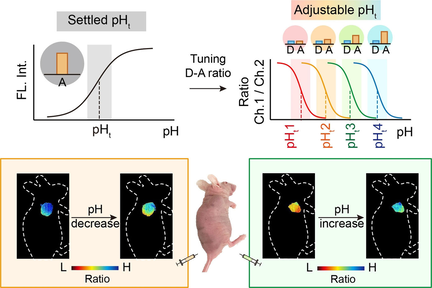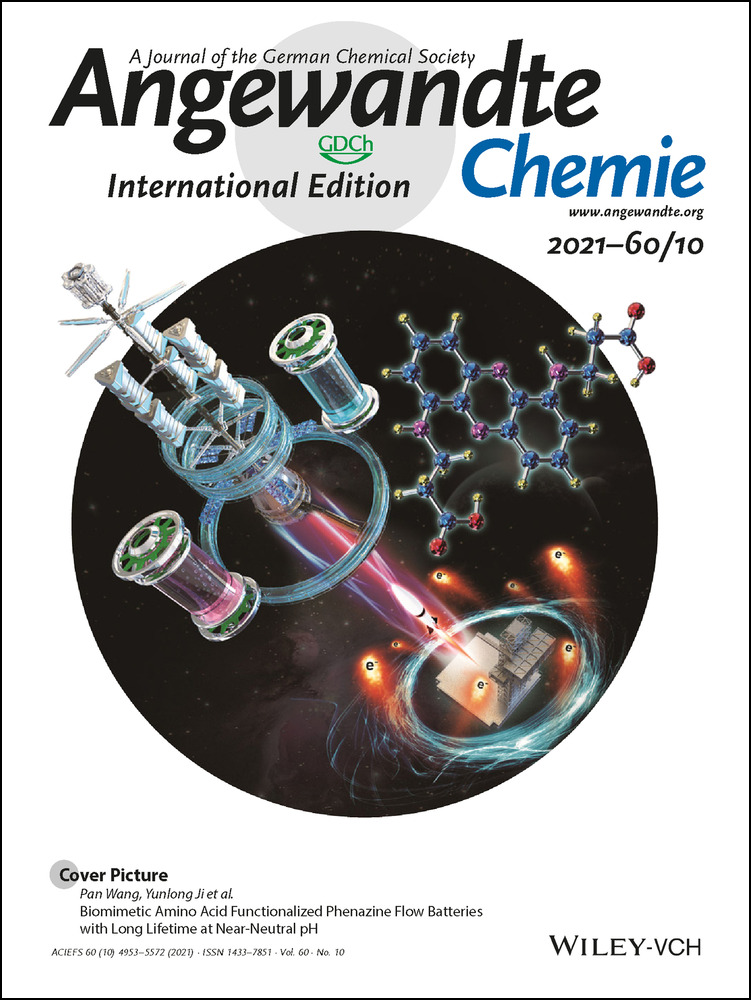NIR-II pH Sensor with a FRET Adjustable Transition Point for In Situ Dynamic Tumor Microenvironment Visualization
Dr. Mengyao Zhao
Department of Chemistry, State Key Laboratory of Molecular Engineering of Polymers and iChem, Shanghai Key Laboratory of Molecular Catalysis and Innovative Materials, Fudan University, Shanghai, 200433 China
These authors contributed equally to this work.
Search for more papers by this authorCorresponding Author
Dr. Jianbo Wang
Department of Chemistry, State Key Laboratory of Molecular Engineering of Polymers and iChem, Shanghai Key Laboratory of Molecular Catalysis and Innovative Materials, Fudan University, Shanghai, 200433 China
College of Biological, Chemical Sciences and Engineering, Jiaxing University, Jiaxing, 314001 China
These authors contributed equally to this work.
Search for more papers by this authorDr. Zuhai Lei
Department of Chemistry, State Key Laboratory of Molecular Engineering of Polymers and iChem, Shanghai Key Laboratory of Molecular Catalysis and Innovative Materials, Fudan University, Shanghai, 200433 China
Search for more papers by this authorLingfei Lu
Department of Chemistry, State Key Laboratory of Molecular Engineering of Polymers and iChem, Shanghai Key Laboratory of Molecular Catalysis and Innovative Materials, Fudan University, Shanghai, 200433 China
Search for more papers by this authorDr. Shangfeng Wang
Department of Chemistry, State Key Laboratory of Molecular Engineering of Polymers and iChem, Shanghai Key Laboratory of Molecular Catalysis and Innovative Materials, Fudan University, Shanghai, 200433 China
Search for more papers by this authorDr. Hongxin Zhang
Department of Chemistry, State Key Laboratory of Molecular Engineering of Polymers and iChem, Shanghai Key Laboratory of Molecular Catalysis and Innovative Materials, Fudan University, Shanghai, 200433 China
Search for more papers by this authorDr. Benhao Li
Department of Chemistry, State Key Laboratory of Molecular Engineering of Polymers and iChem, Shanghai Key Laboratory of Molecular Catalysis and Innovative Materials, Fudan University, Shanghai, 200433 China
Search for more papers by this authorCorresponding Author
Prof. Fan Zhang
Department of Chemistry, State Key Laboratory of Molecular Engineering of Polymers and iChem, Shanghai Key Laboratory of Molecular Catalysis and Innovative Materials, Fudan University, Shanghai, 200433 China
Search for more papers by this authorDr. Mengyao Zhao
Department of Chemistry, State Key Laboratory of Molecular Engineering of Polymers and iChem, Shanghai Key Laboratory of Molecular Catalysis and Innovative Materials, Fudan University, Shanghai, 200433 China
These authors contributed equally to this work.
Search for more papers by this authorCorresponding Author
Dr. Jianbo Wang
Department of Chemistry, State Key Laboratory of Molecular Engineering of Polymers and iChem, Shanghai Key Laboratory of Molecular Catalysis and Innovative Materials, Fudan University, Shanghai, 200433 China
College of Biological, Chemical Sciences and Engineering, Jiaxing University, Jiaxing, 314001 China
These authors contributed equally to this work.
Search for more papers by this authorDr. Zuhai Lei
Department of Chemistry, State Key Laboratory of Molecular Engineering of Polymers and iChem, Shanghai Key Laboratory of Molecular Catalysis and Innovative Materials, Fudan University, Shanghai, 200433 China
Search for more papers by this authorLingfei Lu
Department of Chemistry, State Key Laboratory of Molecular Engineering of Polymers and iChem, Shanghai Key Laboratory of Molecular Catalysis and Innovative Materials, Fudan University, Shanghai, 200433 China
Search for more papers by this authorDr. Shangfeng Wang
Department of Chemistry, State Key Laboratory of Molecular Engineering of Polymers and iChem, Shanghai Key Laboratory of Molecular Catalysis and Innovative Materials, Fudan University, Shanghai, 200433 China
Search for more papers by this authorDr. Hongxin Zhang
Department of Chemistry, State Key Laboratory of Molecular Engineering of Polymers and iChem, Shanghai Key Laboratory of Molecular Catalysis and Innovative Materials, Fudan University, Shanghai, 200433 China
Search for more papers by this authorDr. Benhao Li
Department of Chemistry, State Key Laboratory of Molecular Engineering of Polymers and iChem, Shanghai Key Laboratory of Molecular Catalysis and Innovative Materials, Fudan University, Shanghai, 200433 China
Search for more papers by this authorCorresponding Author
Prof. Fan Zhang
Department of Chemistry, State Key Laboratory of Molecular Engineering of Polymers and iChem, Shanghai Key Laboratory of Molecular Catalysis and Innovative Materials, Fudan University, Shanghai, 200433 China
Search for more papers by this authorGraphical Abstract
Abstract
Monitoring the pH in tumor lesions provides abundant physiological information. However, currently developed pH sensors only achieve sensitive detection in the settled response region around the pH transition point (pHt). To realize tumor pH monitoring with high sensitivity within a wider response region, reported here are serial pHt adjustable sensors (pTAS) that simply regulate the component ratio of second near-infrared (NIR-II) emission aza-BODIPY (NAB) donor and pH sensitive rhodamine-based pre-acceptor (NRh) in Förster resonance energy transfer system. Combining the pH response regions of pTAS, a twofold widened pH detection range (6.11–7.22) is obtained compared to the pHt settled sensor (6.38–6.94). With an adjustable pHt, in vivo tumor pH increase and decrease processes could be dynamically visualized through dual-channel ratiometric bioimaging within the NIR-II window, with a coefficient of variation under 1 % compared to the standard pH meter.
Supporting Information
As a service to our authors and readers, this journal provides supporting information supplied by the authors. Such materials are peer reviewed and may be re-organized for online delivery, but are not copy-edited or typeset. Technical support issues arising from supporting information (other than missing files) should be addressed to the authors.
| Filename | Description |
|---|---|
| anie202012021-sup-0001-misc_information.pdf3 MB | Supplementary |
Please note: The publisher is not responsible for the content or functionality of any supporting information supplied by the authors. Any queries (other than missing content) should be directed to the corresponding author for the article.
References
- 1
- 1aB. Vogelstein, N. Papadopoulos, V. E. Velculescu, S. Zhou, L. A. Diaz, K. W. Kinzler, Science 2013, 339, 1546–1558;
- 1bD. Hanahan, R. A. Weinberg, Cell 2011, 144, 646–674;
- 1cH. Maeda, H. Nakamura, J. Fang, Adv. Drug Delivery Rev. 2013, 65, 71–79.
- 2
- 2aR. A. Cardone, V. Casavola, S. J. Reshkin, Nat. Rev. Cancer 2005, 5, 786–795;
- 2bC. T. Hensley, B. Faubert, Q. Yuan, N. Lev-Cohain, E. Jin, J. Kim, L. Jiang, B. Ko, R. Skelton, L. Loudat, M. Wodzak, C. Klimko, E. McMillan, Y. Butt, M. Ni, D. Oliver, J. Torrealba, C. R. Malloy, K. Kernstine, R. E. Lenkinski, R. J. DeBerardinis, Cell 2016, 164, 681–694.
- 3
- 3aM. G. Vander Heiden, L. C. Cantley, C. B. Thompson, Science 2009, 324, 1029–1033;
- 3bB. A. Webb, M. Chimenti, M. P. Jacobson, D. L. Barber, Nat. Rev. Cancer 2011, 11, 671–677;
- 3cH.-J. Li, J.-Z. Du, J. Liu, X.-J. Du, S. Shen, Y.-H. Zhu, X. Wang, X. Ye, S. Nie, J. Wang, ACS Nano 2016, 10, 6753–6761;
- 3dW. Xuan, Y. Xia, T. Li, L. Wang, Y. Liu, W. Tan, J. Am. Chem. Soc. 2020, 142, 937–944.
- 4
- 4aF. Li, Z. Liang, J. Liu, J. Sun, X. Hu, M. Zhao, J. Liu, R. Bai, D. Kim, X. Sun, T. Hyeon, D. Ling, Nano Lett. 2019, 19, 4213–4220;
- 4bY. Wang, K. Zhou, G. Huang, C. Hensley, X. Huang, X. Ma, T. Zhao, B. D. Sumer, R. J. DeBerardinis, J. Gao, Nat. Mater. 2014, 13, 204;
- 4cT. Ma, Y. Hou, J. Zeng, C. Liu, P. Zhang, L. Jing, D. Shangguan, M. Gao, J. Am. Chem. Soc. 2018, 140, 211–218;
- 4dT. Zhao, G. Huang, Y. Li, S. Yang, S. Ramezani, Z. Lin, Y. Wang, X. Ma, Z. Zeng, M. Luo, E. de Boer, X.-J. Xie, J. Thibodeaux, R. A. Brekken, X. Sun, B. D. Sumer, J. Gao, Nat. Biomed. Eng. 2017, 1, 0006;
- 4eT. Ma, P. Zhang, Y. Hou, H. Ning, Z. Wang, J. Huang, M. Gao, Adv. Healthcare Mater. 2018, 7, 1800391;
- 4fY. Liu, Z. Qu, H. Cao, H. Sun, Y. Gao, X. Jiang, ACS Nano 2017, 11, 12446–12452;
- 4gJ. Lu, J. Sun, F. Li, J. Wang, J. Liu, D. Kim, C. Fan, T. Hyeon, D. Ling, J. Am. Chem. Soc. 2018, 140, 10071–10074;
- 4hD. Ling, W. Park, S.-j. Park, Y. Lu, K. S. Kim, M. J. Hackett, B. H. Kim, H. Yim, Y. S. Jeon, K. Na, T. Hyeon, J. Am. Chem. Soc. 2014, 136, 5647–5655.
- 5
- 5aJ. Jo, C. H. Lee, R. Kopelman, X. Wang, Nat. Commun. 2017, 8, 471;
- 5bS. Ling, X. Yang, C. Li, Y. Zhang, H. Yang, G. Chen, Q. Wang, Angew. Chem. Int. Ed. 2020, 59, 7219–7223; Angew. Chem. 2020, 132, 7286–7290;
- 5cS. Wang, Y. Fan, D. Li, C. Sun, Z. Lei, L. Lu, T. Wang, F. Zhang, Nat. Commun. 2019, 10, 1058;
- 5dQ. Chen, X. Liu, J. Chen, J. Zeng, Z. Cheng, Z. Liu, Adv. Mater. 2015, 27, 6820–6827.
- 6
- 6aJ. Huang, K. Pu, Angew. Chem. Int. Ed. 2020, 59, 11717–11731; Angew. Chem. 2020, 132, 11813–11827;
- 6bG. Hong, A. L. Antaris, H. Dai, Nat. Biomed. Eng. 2017, 1, 0010;
- 6cJ. A. Carr, D. Franke, J. R. Caram, C. F. Perkinson, M. Saif, V. Askoxylakis, M. Datta, D. Fukumura, R. K. Jain, M. G. Bawendi, O. T. Bruns, Proc. Natl. Acad. Sci. USA 2018, 115, 4465–4470;
- 6dB. Li, M. Zhao, L. Feng, C. Dou, S. Ding, G. Zhou, L. Lu, H. Zhang, F. Chen, X. Li, G. Li, S. Zhao, C. Jiang, Y. Wang, D. Zhao, Y. Cheng, F. Zhang, Nat. Commun. 2020, 11, 3102;
- 6eB. Li, L. Lu, M. Zhao, Z. Lei, F. Zhang, Angew. Chem. Int. Ed. 2018, 57, 7483–7487; Angew. Chem. 2018, 130, 7605–7609;
- 6fC. Li, W. Li, H. Liu, Y. Zhang, G. Chen, Z. Li, Q. Wang, Angew. Chem. Int. Ed. 2020, 59, 247–252; Angew. Chem. 2020, 132, 253–258;
- 6gS. Zhu, Z. Hu, R. Tian, B. C. Yung, Q. Yang, S. Zhao, D. O. Kiesewetter, G. Niu, H. Sun, A. L. Antaris, X. Chen, Adv. Mater. 2018, 30, 1802546;
- 6hY. Sun, F. Ding, Z. Chen, R. Zhang, C. Li, Y. Xu, Y. Zhang, R. Ni, X. Li, G. Yang, Y. Sun, P. J. Stang, Proc. Natl. Acad. Sci. USA 2019, 116, 16729–16735;
- 6iY. Yang, S. Wang, L. Lu, Q. Zhang, P. Yu, Y. Fan, F. Zhang, Angew. Chem. Int. Ed. 2020, 59, 18380–18385; Angew. Chem. 2020, 132, 18538–18543;
- 6jF. Ding, Y. Zhan, X. Lu, Y. Sun, Chem. Sci. 2018, 9, 4370–4380;
- 6kB. Shi, N. Ren, L. Gu, G. Xu, R. Wang, T. Zhu, Y. Zhu, C. Fan, C. Zhao, H. Tian, Angew. Chem. Int. Ed. 2019, 58, 16826–16830; Angew. Chem. 2019, 131, 16982–16986.
- 7
- 7aM. Zhao, B. Li, Y. Wu, H. He, X. Zhu, H. Zhang, C. Dou, L. Feng, Y. Fan, F. Zhang, Adv. Mater. 2020, 32, 2001172;
- 7bJ. Peng, A. Samanta, X. Zeng, S. Han, L. Wang, D. Su, D. T. B. Loong, N.-Y. Kang, S.-J. Park, A. H. All, W. Jiang, L. Yuan, X. Liu, Y.-T. Chang, Angew. Chem. Int. Ed. 2017, 56, 4165–4169; Angew. Chem. 2017, 129, 4229–4233.
- 8M. R. L. Stratford, C. S. Parkins, S. A. Everett, M. F. Dennis, M. Stubbs, S. A. Hill, J. Chromatogr. A 1995, 706, 459–462.
- 9J. Goodwin, K. Yachi, M. Nagane, H. Yasui, Y. Miyake, O. Inanami, A. A. Bobko, V. V. Khramtsov, H. Hirata, NMR Biomed. 2014, 27, 453–458.





